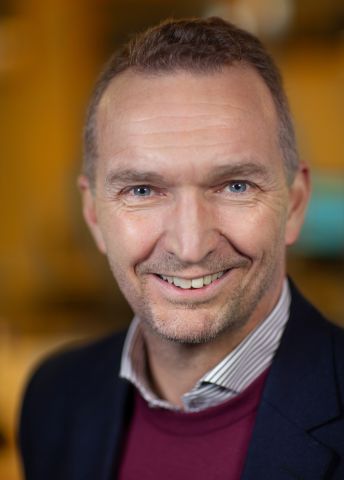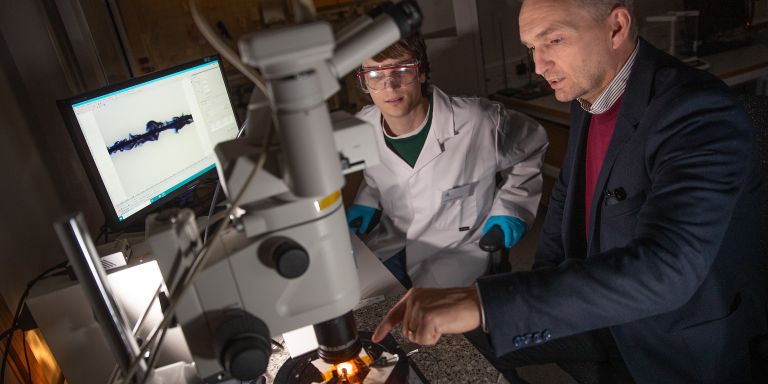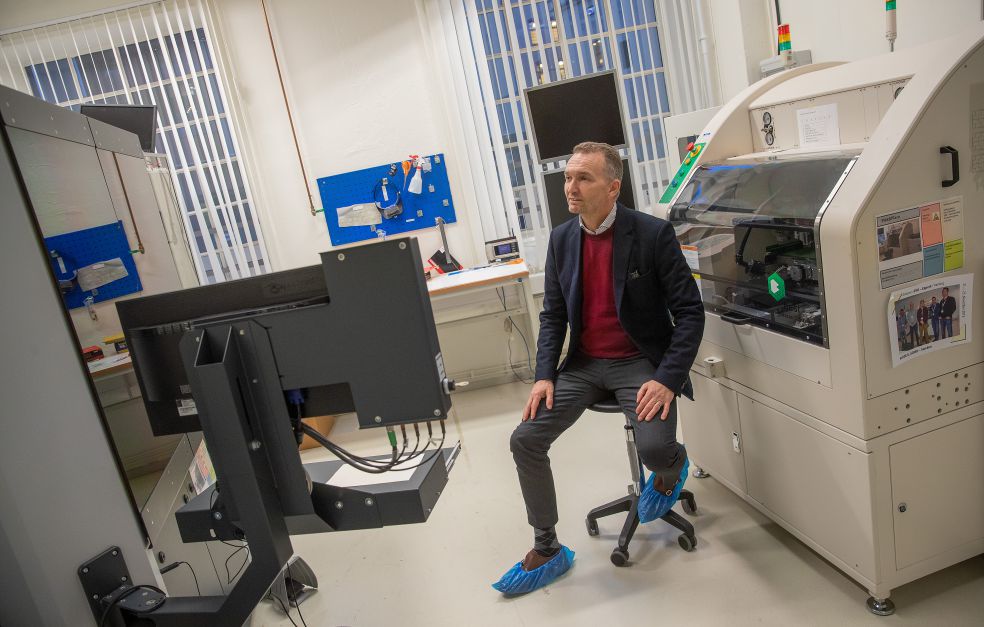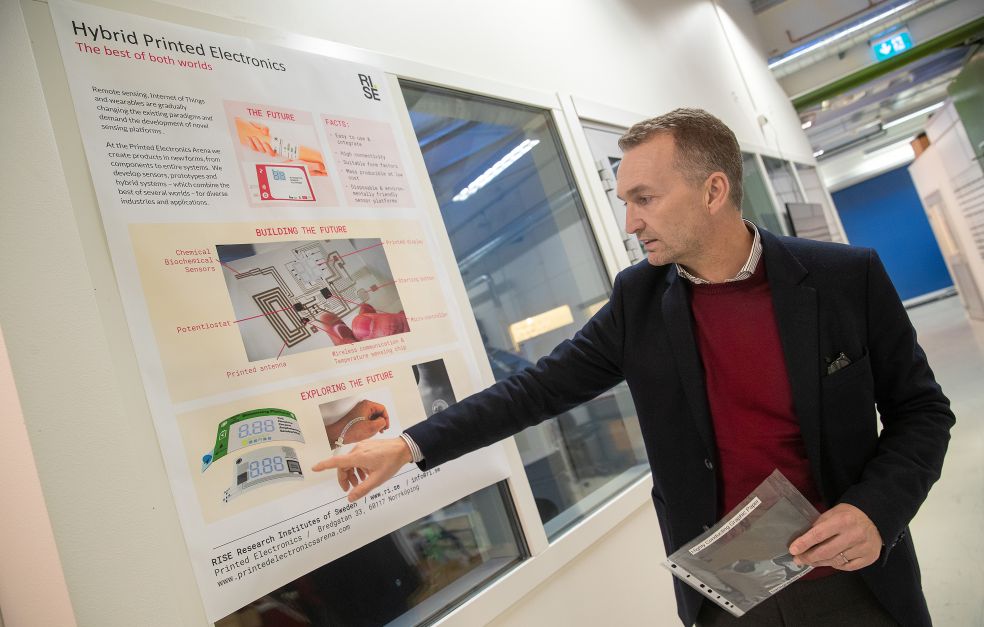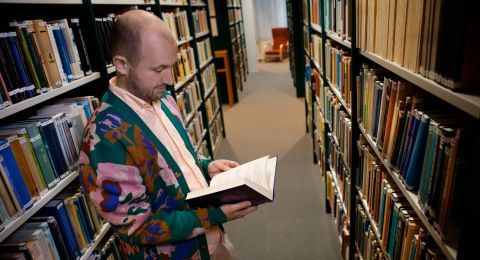Over the past twenty years new discoveries have come thick and fast out of Magnus Berggren’s research laboratory. Just recently, for instance, the lab produced the first ever material that can change from a solid phase to a gel with the help of electricity.
Magnus Berggren
Professor of Organic Electronics
Wallenberg Scholar
Institution:
Linköping University
Research field:
Organic electronics for new applications, including medicine, plant biology, electronic paper and energy conversion.
“Look at this – it’s absolutely astounding!”
Berggren points at a screen in the lab, where PhD student Johannes Gladisch has prepared a movie show. The images have been captured by a nearby microscope, and show how a polymer is transformed from a solid state into a gel – all with the help of about 0.8 volts.
“This is a huge discovery, and marks the birth of an entirely new field of research. No one has ever demonstrated that a transition from a solid phase to a gel can be achieved using electricity,” says Berggren, who is Professor of Organic Electronics and Director of the Laboratory of Organic Electronics.
The polymer takes the form of a thin coating along a conductive carbon fiber. When a voltage is applied to the fiber, the volume of the polymer increases more than a hundredfold, and the material changes into a gel. The opposite voltage causes the material to revert partly to its original solid state.
“Our success would not have been possible without the support of Knut and Alice Wallenberg Foundation. Without that support I would never have had the confidence to take such risks – to shoot from the hip so often.”
Key component
The discovery was published in Advanced Science in 2019, and attracted a great deal of international attention.
“When my colleague Eleni Stavrinidou and I saw it for the first time, it was like having chaos injected into our heads. My experience told me it was impossible to change a polymer in this way, by purely electrical means. But when we’d made the necessary calculations, we realized that it is actually possible with this specific material.”
The unique material is the fruit of collaboration with researcher Iain McCulloch at Imperial College London, who designed the actual material. Berggren now envisions how the polymer could become a key component in many biomedical and biotech fields.
One initial idea is to use the material for filtering purposes. The researchers can then control the size of the particles passing through by applying different voltages to the filter.
“But this technology is completely new, and there is usually no shortage of applications for innovative technologies of this kind, often where you least expect them. We’ve made some similar discoveries over the years, but this is definitively one of the most amazing ones,” Berggren enthuses.
Rapid growth
Since its inception in 1999, research at what is now the Laboratory of Organic Electronics in Linköping has grown from two PhD students to a current staff of 135 researchers.
“We have made a fantastic journey, in which Knut and Alice Wallenberg Foundation and the Swedish Foundation for Strategic Research have been our principal funding sources. They have given us free rein for extensive research, requiring only a modest degree of reporting. When numerous projects are running simultaneously, reporting on their progress is normally something that uses up the time that could be used for research.”
Now that Berggren’s Scholar grant has been extended, he will be able to develop the lab further.
“The Scholar grant has been absolutely central to our progress. At least three new projects were started on the back of the last grant. And the discovery of electronic gel can also be traced back to that period.”
When Berggren was appointed professor of organic electronics at the age of 34, he already had a fair amount of experience under his belt. He spent some time as CEO of a research-based company, before going on to develop research ideas for companies at RISE Research Institutes of Sweden (then known as Acreo).
But it was his stint as a postdoc at Bell Labs in the U.S. that influenced him the most. He was impressed by Bell’s organization, where research always came first.
“There was a strong collegial community, and everyone shared a sense of responsibility for the lab. That’s how I’ve tried to shape our own approach to research. We don’t engage in hierarchies or empire-building. All money we receive goes straight to the maximum number of hours of top-class research in the lab.”
He describes the lab as a flat organization in which all researchers, whatever their seniority, work in an open-plan arrangement, each occupying exactly the same amount of space. This facilitates unexpected collaborations and the rapid spread of new ideas.
“We have no secrets here. All new ideas are shared immediately with the whole lab. And if a researcher develops someone else’s idea, feedback is given to the originator.”
The recipe has turned out to be highly successful. In 2019 the lab published 80 research articles, ten of which were in the various periodicals published by Nature Research and AAAS (Science).
Front page of the New York Times
And the lab produced one of Linköping University’s most widely-read research articles of all time. The research by Berggren and his colleagues Eleni Stavrinidou and Daniel Simon into electronic plants even made it onto the front page of the New York Times. With the help of a conductive polymer, Stavrinidou created electrical and electronic networks in roses. There are potential applications for this technology both in plant breeding and in energy storage.
This project, too, can be traced back to the Scholar grant. Berggren explains:
“I used the Scholar funding to recruit Eleni Stavrinidou and other researchers to the laboratory. My strategy, and that of the laboratory, is to take on a successful young researcher roughly every other year – always within a complementary field of expertise.”
Each young researcher is given two research tasks when they are recruited: one where it is reasonably possible to foresee the outcome in advance, and one that is something of a wild idea. Stavrinidou was given the crazy notion of inserting electronics into a living plant. The rest is history.
Berggren shares facilities with RISE, which has been a contributing partner in most of the lab’s ten-plus spin-offs. There are just as many waiting in the wings, ready to be launched over the next few years.
“We’re going full out to set the agenda for the electronic gelling process. And I wouldn’t be surprised if it results in a couple of new spin-offs in a year or two,” Berggren says.
Text Magnus Trogen Pahlén
Translation Maxwell Arding
Photo Magnus Bergström
